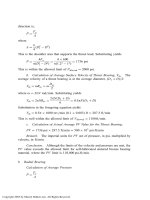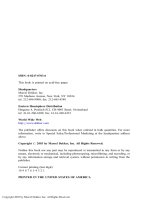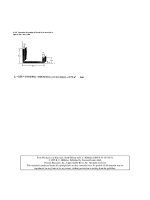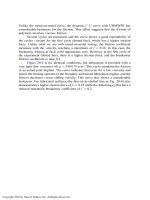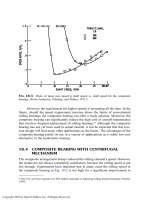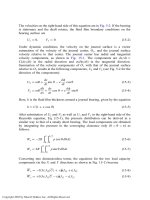Bearing Design in Machinery Episode 3 Part 12 doc
Bạn đang xem bản rút gọn của tài liệu. Xem và tải ngay bản đầy đủ của tài liệu tại đây (245.39 KB, 17 trang )
Unlike the metal-on-metal curve, the dynamic f –U curve with UHMWPE has
considerable hysteresis for dry friction. This effect suggests that the friction of
polymers involves viscous friction.
Several cycles are measured, and the curve shows a good repeatability of
the cycles—except for the first cycle (dotted line), which has a higher stiction
force. Unlike what we see with metal-on-metal testing, the friction coefficient
increases with the velocity, reaching a maximum of f ¼ 0:26. In this case, the
breakaway friction at each cycle approaches zero. However, at the first cycle of
the experiment (dotted line), there is a higher stiction force, and the breakaway
friction coefficient is near 0.2.
Figure 20-4 is for identical conditions, but lubrication is provided with a
very light (low viscosity) oil, m ¼ 0:001 N-s=m
2
. This curve simulates the friction
in an actual joint implant. The curve indicates that even for a low viscosity and
speed, the bearing operates in the boundary and mixed lubrication regime, and the
friction decreases versus sliding velocity. This curve also shows a considerable
hysteresis. For lubricated surfaces, the first cycle (dotted line in Fig. 20-4) also
demonstrates a higher stiction force of f ¼ 0:25 while the following cycles have a
reduced maximum breakaway coefficient of f ¼ 0:2.
Copyright 2003 by Marcel Dekker, Inc. All Rights Reserved.
Bibliography
Air Force Aero Propulsion Laboratory (1977): ‘‘Gas Lubricated Foil Bearing Development
for Advanced Turbomachines’’, Report AF APL-TR-76-114, Vol. I and II.
ASTM, B23 (1990): ASTM Standards, ASTM Philadelphia, Vol. 02.04, pp. 9–11.
Allaire, P. E., and Flack, R. D. (1980): Journal Bearing Design for High Speed Turbo-
machinary. Bearing Design – Historical Aspects, Present Technology and Future
Problems. W. J. Anderson (editor). ASME publication, New York, pp. 111–160.
Amin J., Friedland B., and Harnoy, A. (1997): ‘‘Implementation of a Friction Estimation and
Compensation Technique’’ IEEE Control Systems, Vol. 17, No. 4, pp. 71–76.
Anderson, W. J., Fleming, D. P., and Parker, R. J. (1972): ‘‘The Series-Hybrid Bearing – A
New High-Speed Bearing Concept’’, ASME Trans. J. of Lubrication Technology, Series
F, Vol. 94, No. 2, pp. 117–124.
Anderson, W. J. (1973): ‘‘High Speed Hybrid Bearing, A Fluid Bearing and Rolling Bearing
Connected in Series’’, U. S. Patent No. 3,759,588.
Armstrong-He
´
louvry, B. (1991): ‘‘Control of Machines with Friction’’, Kluwer Academic
Publishers, Boston, Massachusetts.
Arsenius, H. C., and Goran R. (1973): ‘‘The Design and Operational Experience of a Self
Adjusting Hydrostatic Shoe Bearing for Large Size Runners’’, Instn. Mech. Engrs.
C303, pp. 361–367.
Avila, F., and Binding, D. M. (1982): ‘‘Normal and Reverse Squeezing Flows’’, Journal of
Non-Newtonian Fluid Mechanics, 11, pp. 111–126.
Bamberger, E. N., (1983): ‘‘Status of Understanding of Bearing Materials’’ Tribology in the
’80s. Vol. 2, NASA CP-2300-VOL-2, Editor: W. F. Loomis, pp. 773–794.
Barus, C., (1893): ‘‘Isothermals, Isopiestics, and Isometrics Relative to Viscosity’’. Amer.
Journal of Science, Vol. 45, pp. 87–96.
Bassani, R. and Piccigallo, B. (1992): Hydrostatic Lubrication, Elsevier.
Barwell, F. T. (1979): Bearing Systems, Principles and Practice, Oxford University Press.
Bell, R., and Burdekin, M., (1969): ‘‘A Study of the Stick-Slip Motion of Machine Tool
Feed Drives’’, Inst. of Mech. Engr. 184, 29, pp. 543–560.
Blau, J. P. (1992): ASM Handbook, Friction, Lubrication, and Wear Technology, Vol. 18,
ASM International.
Blau, J. P. (1995): ‘‘Friction Science and Technology’’, Marcel Dekker, Inc. NY.
Booker, J. F. (1965): ‘‘ATable of the Journal–Bearing Integrals’’, J. Basic Eng., Vol. 87, no.
2, pp. 533–535
Booser, E. R., Ryan, F., and Linkinhoker, C. (1970): ‘‘Maximum temperature for hydro-
dynamic bearings under steady load’’, Lubrication Engineering, Vol. 26, pp. 226–235.
Copyright 2003 by Marcel Dekker, Inc. All Rights Reserved.
Booser, E. R. (1992): ‘‘Bearing materials’’, Encyclopedia of Chemical Technology, 4th Ed.
Vol. 4, John Wiley, pp. 1–21.
Bowden, F. P., and Tabor, D. (1956): Friction and Lubrication, John Wiley.
Bowden, F. P., and Tabor, D. (1986): The Friction and Lubrication of Solids, Oxford Science
Press, England.
Brewe, D. E., and Hamrock, B. J. (1977): Simplified Solution for Elliptical Contact
Deformation Between Two Elastic Solids. J. Lubr. Technol., Vol. 99, no. 4, pp 485–
487.
Brough, D., Bell, W. F., and Rowe, W. B. (1980): ‘‘Achieving and monitoring high rate
centerless grinding,’’ Proc. of 21 Int. Con. on Machine Tool Design and Research,
University of Swansea.
Charnley, J. (1979): ‘‘Low Friction Arthroplasty of the Hip’’, Springer-Verlag, pp. 1–376.
Chiu Y. P., Pearson, P. K., and Daverio, H. (1995): ‘‘Fatigue Life and Performance Testing of
Hybrid Ceramic Ball Bearings’’ Lubrication Engineering, Vol, 52, No. 3, pp. 198–204.
Cole, J. A., and Hughes C. J. (1956): Oil Flow and Film Extent in Complete Journal
Bearings, Proc. Inst. Mech. Engrs. (London), Vol. 170, no. 17.
Coleman, B. O., and Noll, W. (1960): ‘‘An Approximation Theorem for Functionals with
Applications in Continuum Mechanics’’, Arch. Tat. Mech. Anal. Vol. 6, p. 355.
Cooke, A. F., Dowson, D., and Wright, V. (1978): ‘‘The Rheology of Synovial Fluid and
Some Potential Synthetic Lubricants.’’ Engineering and Medicine, Vol. 7, pp. 66–72.
Crankshaw, E., and Menrath, J. (1949): Mechanical Features of Steel-Backed Bearings,
Sleeve Bearing Materials, American Society of Materials, pp. 150–164.
Dahl, P. R. (1968): ‘‘A Solid Friction Model’’, AFO 4695-67-C-D158, The Aerospace
Corporation, El Segundo, California.
Dahl, P. R. (1977): ‘‘Measurement of Solid Friction Parameters of Ball Bearings’’, Proc. of
6th Annual Symp. On Incremental Motion, Control Systems and Devices. Champaign,
IL, May 24–27.
Decker O. and Shapiro, W. (1968): ‘‘Computer-Aided Design of Hydrostatic Bearings for
Machine Tool Applications’’, Proc. of 9th Int. Con. on Machine Tool Design and
Research, University of Birmingham, pp. 797–839.
Deutschman, A. D., Michels W. J., and Wilson C. E. (1975): Machine Design Theory and
Practice, Macmillan Publishing Co. NY.
Donaldson, R. R. and Patterson, S. R. (1983): ‘‘Design and Construction of a Large Vertical
Axis Diamond Turning Machine,’’ Lawrence Livermore, preprint UCRL 89738.
Dowson, D., and Higginson, G. R. (1966): Elastohydrodynamic Lubrication, The Funda-
mentals of Roller and Gear Lubrication. Pergamon, Oxford.
Dowson, D. and Zhong-Min Jin (1986): ‘‘Micro-Elastohydrodynamic Lubrication of
Synovial Joints.’’ Engineering in Medicine, Vol. 5 (No. 2), pp. 63–65.
Dowson, D. (1992): ASM Handbook, Friction, Lubrication, and Wear Technology, Vol. 18,
ASM International, pp. 656–662.
Dowson, D. (1998): ‘‘Advances in Medical Tribology’’, Mechanical Engineering Publica-
tions Limited, London.
Dubois, G. B., and Ocvirk, E. W. (1953): ‘‘Analytical Derivation and Experimental
Evaluation of Short Bearing Approximation for Full Journal Bearings,’’ NASA
Report 1157.
Copyright 2003 by Marcel Dekker, Inc. All Rights Reserved.
Dubois, G. B., Ocvirk, E. W., and Wehe, R. L. (1960): ‘‘Study of Effect of a Non-Newtonian
Oil on Friction and Eccentricity Ratio of a Plain Journal Bearing,’’ NASA TN D 427.
Dupont, P. E., and Dunlap, E. (1993): Friction Modeling and Control in Boundary
Lubrication, Proc. American Control Conference, AACC, San Francisco, CA, pp.
1915–1919.
Earles, L. L., Palazzolo, A. B., and Armentrout, R. W. (1989): ‘‘A Finite Element Approach
to Pad Flexibility Effects in Tilt Pad Journal Bearings,’’ ASME/STLE Tribology
Conference, Oct. 17–18, 1989, Fort Lauderdale, Florida.
Ernst, H., and Merchant, M. E. (1940): ‘‘Chip Formation, Friction and Finish,’’ Cincinnati
Milling Machine Co. Report, Aug. 24, 1940.
FAG (1986): ‘‘Rolling Bearing and their Contribution to the Progress of Technology’’, p.
191.
FAG (1998): ‘‘The Design of Rolling Bearing Mountings’’, Publication No. WL 00 200/5
EA.
FAG (1999): ‘‘FAG Rolling Bearing Catalogue’’, WL 41520/3 EA.
Fisher T. E., and Tomizawa, H. (1985): ‘‘Interaction of Tribochemistry and Microfracture in
the Friction and Wear of Silicon Nitride’’, Wear, Vol. 105, p. 29.
Gibson, H. (2001): ‘‘Lubrication of Space Shuttle Main Engine Turbopump Bearings’’,
Lubrication Engineering, Vol. 57, no. 8, pp. 10–12.
Girard, L. D., (April 1851): Comptes Rendus, Vol. 28.
Gluck, T. (1891): Arch Klin Chir. Vol. 41, p. 186.
Grimm, R. J. (1978): AIChE J. Vol. 24 No. 3, p. 427.
Hamrock, B. J., and Anderson, W. J. (1973): Analysis of an Arched Outer-Race
Ball Bearing Considering Centrifugal Forces. J. Lubr. Technol., Vol 95, no. 3,
pp. 265–276.
Hamrock, B. J., and Brewe, D. E. (1983): ‘‘Simplified Solution for Stresses and Deforma-
tions’’, J. Lubr. Technol., Vol. 105, no. 2, pp. 171–177.
Hamrock, B. J., and Dowson, D. (1977): Isothermal Elastohydrodynamic Lubrication of
Point Contact, part III—Fully Flooded Results, J. of Lubrication Technology, Vol. 98,
no. 3, pp. 375–383.
Hamrock, B. J., and Dowson, D. (1981): Ball Bearing Lubrication – The Elastohydro-
dynamics of Elliptical Contacts. Wiley-Interscience, New York.
Hamrock, B. J. (1994): Fundamentals of Fluid Film Lubrication, McGraw-Hill Inc. NY.
Harnoy, A. (1966): ‘‘Composite Bearing-Rolling Element with Hydrodynamic Journal,’’
M.S thesis, Technion, Israel Inst. of Technology.
Harnoy, A. (1974): ‘‘The Effects of Stress Relaxation and Cross Stresses in Lubricants with
Polymer Additives’’, CNRS publication, No. 233, pp. 37–44.
Harnoy, A., and Hanin, M. (1974): ‘‘Second Order, Elastico-Viscous Lubricants in
Dynamically Loaded Bearings’’, ASLE Transactions, Vol. 17, pp. 166–171.
Harnoy, A., and Phillippoff, W. (1976): ‘‘Investigation of Elastico-Viscous Lubrication of
Sleeve Bearing’’, ASLE Transactions, Vol. 19, pp. 301–308.
Harnoy, A. (1976): ‘‘Stress Relaxation Effect in Elastico-Viscous Lubricants in Gears and
Rollers’’, Journal of Fluid Mechanics, Cambridge U.K., Vol. 19, pp. 501–517.
Harnoy, A. (1977): ‘‘Three Dimensional Analysis of the Elastico-Viscous Lubrication of
Journal Bearings’’, Rheologica Acta, Vol. 16, pp. 51–60.
Copyright 2003 by Marcel Dekker, Inc. All Rights Reserved.
Harnoy, A. (1978): ‘‘An Investigation into the flow of Elastico-Viscous Fluids Past a
Circular Cylinder’’, Rheologica Acta, Vol. 26, pp. 493–498.
Harnoy, A. (1978): ‘‘An Analysis of Stress Relaxation in Elastico-Viscous Fluid Lubrication
of Journal Bearings’’, ASME Transactions, Journal of Lubrication Technology, Vol. 100,
pp. 287–295.
Harnoy, A. (1979): ‘‘The role of the Fluid Relaxation Time in Laminar Elastico-Viscous
Boundary Layers’’, Rheologica Acta, Vol. 18, pp. 220–216.
Harnoy, A. (1987): ‘‘Squeeze Film Flow of Elastic Fluids at Steady Motion and Dynamic
Loads’’, ASME Transactions, Journal of Tribology, Vol. 109, pp. 691–695.
Harnoy, A., and Sood, S. S. (1989): ‘‘Viscoelastic Effects in the Performance of Dynami-
cally Loaded, Short Journal Bearings,’’ ASME Transactions, Journal of Tribology, Vol.
111, pp. 555–556.
Harnoy, A. (1989): ‘‘Normal Stresses and Relaxation Effects in Viscoelastic Boundary
Layer Flow Past Submerged Bodies.’’ Journal of Rheology, Vol. 33, pp. 93–117.
Harnoy, A., and Zhu, H. (1991): ‘‘The Role of the Elasticity of the Lubricant in Rotor
Dynamics,’’ Tribology Transactions, Vol. III, No. 4, pp. 353–360.
Harnoy, A., and Rachoor, H. (1993): ‘‘Angular-Compliant Hydrodynamic Bearing Perfor-
mance Under Dynamic Loads,’’ ASME, Transaction, Journal of Tribology, Vol. 115, pp.
342–347.
Harnoy, A., Friedland, B., Semenock, R., Rachoor, H., and Aly, A. (1994): ‘‘Apparatus for
Empirical Determination of Dynamic Friction,’’ Proceedings of ACC Conference,
Baltimore, Maryland, June 29–July 1, 1994, Vol. 1, pp. 545–550.
Harnoy, A., and Friedland, B. (1994): ‘‘Dynamic Friction Model of Lubricated Surfaces for
Precise Motion Control,’’ Tribology Transactions, Vol. 37, No. 3, pp. 608–614.
Harnoy, A., and Friedland, B., and Rachoor, H. (1994): ‘‘Modeling and Simulation of
Elastic and Friction Forces in Lubricated Bearings for Precise Motion Control,’’ Wear, J.
of science and Technology, Oxford UK, vol. 12, p.p. 155–165.
Harnoy, A. (1995): ‘‘Model Based Investigation of Friction During the Start-up of
Hydrodynamic Journal Bearings,’’ ASME Transactions, Journal of Tribology, Vol.
117, pp. 667–672.
Harnoy, A. (1996): ‘‘Simulation of stick-slip in control systems,’’ Tribology Transactions,
Vol. 40, pp. 360–366.
Harnoy, A., and Khonsari, M. M. (1996): ‘‘Hydro-Roll: A Novel Bearing Design With
Superior Thermal Characteristics,’’ Tribology Transactions, Vol. 39, No. 2, pp. 455–461.
Harnoy, A. (1996): ‘‘Simulation of Stick–Slip in Control Systems’’, Tribology Transactions,
Vol. 40, pp. 360–366.
Harris, T. A. (1984): Rolling Bearing Analysis. John Wiley, New York.
Hertz, H. (1881): The Contact of Elastic Solids. J. Reine Angew Math., Vol. 92, pp. 156–
171.
Heshmat, H., Shapiro, W., and Gray, S. (1982): Development of Foil Journal Bearings for
High Load Capacity and High Speed Whirl Stability, Trans ASME, J. Lub. Tech., pp.
149–156.
Hess, D. P, and Soom, A., (1990): ‘‘Friction at a Lubricated Line Contact Operating at
Oscillating Sliding Velocities’’, ASME Transactions, Journal of Tribology, Vol. 112, pp.
147–152.
Copyright 2003 by Marcel Dekker, Inc. All Rights Reserved.
Higginson, G. R. (1978): ‘‘Elastohydrodynamic Lubrication in Human Joints.’’ Engineering
in Medicine, Vol. 7 (No. 1), pp. 35–41.
Hodgekinson, F. (1923): ‘‘Improvements relating to lubrication of bearings,’’ British Pat.
18595.
Horowitz, H. H., and Steidler, F. E. (1960): ‘‘The Calculated Journal Bearing Performance
of Polymer Thickened Lubricants,’’ ASLE Trans., Vol. 3, p. 124.
Hosang G. W., Heshmat, H. W. (1987): ‘‘Result and Design Techniques from the
Application of Ceramic Ball Bearings to the MREADCOM 10 kW Turbine’’, AIAA,
SAE, ASME, ASEE, 23rd Joint Propulsion Conference, June 29–July 2, 1987, San
Diego.
Jones, A. B. (1946): ‘‘New Departure Engineering Data; Analysis of Stresses and
Deflections’’. Vols. I and II, General Motors, Inc., Detroit, Michigan.
Jones, W. R. et al. (1975): ‘‘Pressure-viscosity Measurements for Several Lubricants’’,
ASLE Trans., Vol. 18, no. 4, pp. 249–262.
Judet, J., and Judet, R. (1950): ‘‘The Use of an Artificial Femoral Head for Arthroplasty of
the Hip Joint’’, J. Bone Joint Surg., Vol. 32B, p. 166.
Kaufman, H. N. (1980): ‘‘Tribology; Friction, Lubrication and Wear’’ Szeri, A. Z.,
Hemisphere, pp. 477–505.
Kennedy, F E., Booser, E.R., and Wilcock, D. F. (1998): ‘‘Tribology, Lubrication, and
Bearing Design,’’ Handbook of Mechanical Engineering CRC Press, Boca Raton, FL.
Kher, A. K., and Cowley, A. (1967): ‘‘The Design and Performance Characteristic of a
Capillary Compensated Hydrostatic Journal Bearing’’, Proc. of 8th Int. Con. on Machine
Tool Design and Research, University of Birmingham, pp. 397–418.
Khonsari, M. (1987): ‘‘A Review of Thermal Effects in Hydrodynamic Bearings, Part I and
II’’, ASLE Trans., pp. 19–26.
Kingsbury, G. R. (1997): ‘‘Oil Film Bearing Materials’’, Tribology, Data Handbook, CRC
Press, Boca Raton, FL, pp. 503–525.
Leider, P. J., and Bird, R. B. (1974): ‘‘Squeezing Flow Between Parallel Disks. I. Theoretical
Analysis. II. Experimental Results,’’ Ind. Eng. Fundam., Vol. 13, pp. 336–346.
Licht, L. (1972): The Dynamic Characteristics of a Turborotor Simulator on Gas-Lubricated
Foil Bearings, ASME Trans., J. Lub. Tech., Vol. 94, pp. 211–222.
Loewy, K., Harnoy, A., and Bar-Nefi, S. (1972): ‘‘Composite Bearing, Rolling Element with
Hydrodynamic Journal’’, Israel Journal of Technology, Vol. 10, pp. 271–278.
Ludema, K. C. (1996): Friction, Wear, Lubrication, CRC Press, Boca Raton FL.
Lundberg, G., and Palmgren, A. (1947): Dynamic Capacity of Rolling Bearings. Acta
Polytech., Mech. Eng. Ser., Vol. 1, no. 3 (Stockholm) pp. 6–9.
Mahoney, O. M., and Dimon, J. H. (1990): ‘‘Unsatisfactory Results With a Ceramic Total
Hip Prosthesis.’’ Journal of Bone and Joint Surgery, Vol 72A, p 663.
McKee, S. A. (1928): ‘‘The Effect of Running-In on Journal Bearing Performance’’, Mech.
Eng., Vol. 50, pp. 528–533.
McKee, S. A., and McKee, T. R. M. (1929): ‘‘Friction of Journal Bearings as Influenced by
Clearance and Length’’, Trans. Am. Soc. Mech. Eng, Vol. 51, pp. 161–171.
McKee, G. K., and Watson-Farrar, J. (1966): ‘‘Replacement of the Arthritis Hips by the
McKee-Farrar Prostethesis’’ J. Bone Joint Surg., Vol. 48B (No. 2), p. 245.
Copyright 2003 by Marcel Dekker, Inc. All Rights Reserved.
McKee, G. K. (1967): ‘‘Developments of Total Hip Replacement’’, Proc. Inst. Mech. Engr.
Vol. 181, pp. 85–89.
McKellop, H., Clarke, I., Markolf, K., and Amstut, H. (1981): ‘‘Friction and Wear
Properties of Polymer, Metal, and Ceramic Prosthetic Joint Materials Evaluated on a
Multichannel Screening Device.’’ Journal of Biomedical Materials Research, Vol. 15, p
619–653.
Mirra, J. M., Amstutz, H. C., Matos, M., and Gold, R. (1976): ‘‘The Pathology of Joint
Tissues and its Clinical Relevance in Prosthesis Failure’’, Clin. Orthop., Vol 117, pp.
221–240.
Moore, A. T. (1959): ‘‘The Moore Self-Locking Vitallium Prosthesis in Fresh Femoral Neck
Frames. A New Low Posterior Approach’’, Am Acad. Orthoped. Surg., Vol. 16, p. 166.
Mukherjee, A., Bhattacharyya, R., Rao Dasary, A. M. (1985): ‘‘A Theoretical Study of
Stability of a Rigid Rotor Under the Influence of Dilute Viscoelastic Lubricants’’,
ASME Transactions, J. of Lubrication Technology, Vol. 107, pp. 75–81.
Mukherjee, A., Bhattacharyya, R., Rao Dasary, A. M. (1984): ‘‘A Theoretical Inquiry into
the Molecular Origin of Harnoy’s Idea for Constitutive Relations for Viscoelastic
Lubricants at High Shear rates’’, DSC Thesis I.I.T., ME Dept., Kharagpur 72130, India.
Mutoh, Y., Tanaka, K., and Uenohara, M. (1994): Retainer-Dependent Wear of Silicone
Nitride Bearings at High Temperatures, ASME Transactions, Journal of Tribology Vol.
116, pp. 463–469.
Norton, R. L. (1996): Machine Design. An Integrated Approach, Prentice-Hall.
Nolan, J. F., and Phillips, H. (1996): ‘‘Joint Replacement and Particulate Wear Debris.’’
Lancet, 348 (9031), pp. 839–840.
Ogawa, H., and Aoyama, T. (1991): ‘‘Application of the Advanced Ceramics to Sliding
Guideways: Friction Wear Characteristics Under Water Based Lubrication’’ PED Vol.
54, TRIB Vol. 2, Tribological Aspects in Manufacturing, ASME, pp. 51–60.
Okrent, E. H. (1961): ‘‘The Effect of Lubricant Viscosity and Composition on Engine
Friction and Bearing Wear,’’ ASLE Trans., Vol. 4, p. 97, and Vol. 7, 1964, p. 147.
O’Kelly, J., Unsworth, A., Dowson, D., Jobbins, B., and Wright, V. (1977): ‘‘Pendulum and
Simulator for Studies of Friction in Hip Joints.’’ Evaluation of Artificial Joints, Ed. D.
Dowson and V. Wright, Biological Engineering Society, pp. 19–29.
Oldroyd, J. G. (1959): Proc. Roy. Soc. A, 245, pp. 278–297.
Opitz, H. (1967): Pressure pad bearings, Proc. Inst. of Mech. Engrs., Lubrication and Wear,
London.
Orndorff, R. L., and Tiedeman, C. R. (1977): ‘‘Water-Lubricate Rubber Bearings, History
and New Developments,’’ Society of Naval Architects and Marine Engineers, San
Diego, pp. 49.
Pan, P., and Hamrock, B. J. (1989): Simple Formulae for Performance Parameters Used in
Elastohydrodynamically Lubricated Line Contacts, J. of Tribology, Vol. 111, no. 2, pp.
246–251.
Pappas, J. M., Schmidt, A. C., Shanbhag, A. S., Whiteside, T. A., Rubash, H. E., Herndon,
J. H. (1996): ‘‘Biological Response to Particulate Debris from Nonmetallic Orthopedic
Implants’’, Human Biomaterials Applications, Humana Press, Totowa, NJ, pp. 115–135.
Peterson, M. B., and Winer, W. O., Eds. (1980): Wear Control Handbook, ASME, NY.
Pinkus, O. and Sternlicht, B. (1961): Theory of Hydrodynamic Lubrication, McGraw-Hill.
Copyright 2003 by Marcel Dekker, Inc. All Rights Reserved.
Polycarpou, A., and Soom, A. (1995): ‘‘Two dimensional Models of Boundary and Mixed
Friction of a Line Contact’’, ASME J. of Tribology, Vol. 117, pp. 178–184.
Polycarpou, A., and Soom, A. (1996): ‘‘A Two Component Mixed Friction Model for a
Lubricated Line Contact’’, ASME J. of Tribology, Vol. 117, pp. 178–184.
Prager, W. (1961): ‘‘An Elementary Discussion of Definitions of Stress Rate’’, Quart. Appl.
Math. Vol. 18, p. 403.
Rabinovitz, E. (1951): ‘‘The Nature of the Static and Kinematic co efficient of Friction’’,
J. of Applied Physics, Vol. 22, no. 1, pp. 668–675.
Rabinowicz, E. (1965): Friction and Wear of Materials, John Wiley, NY.
Rachoor, H. and Harnoy, A. (1996): ‘‘Modeling of Friction in Lubricated Line Contacts for
Precise Motion Control,’’ Tribology Transactions, Vol. 39, pp. 476–482.
Raimondi, A. A., and Boid, J. (1954): An Analysis of Capillary Compensated Hydrostatic
Journal Bearings. Westinghouse Research Laboratories, paper No. 60-94451-8-PI.
Raimondi, A. A., and Boyd, J. (1955): Applying Bearing Theory to the Analysis and Design
of Pad-Type Bearing. ASME Trans., Vol. 77, No. 3, pp. 287–309.
Raimondi, A. A., and Boid, J. A. (1958): Solution for the Finite Journal Bearing and its
Application to Analysis and Design, Part III, ASLE Transactions, Vol. 1, no. 1 pp. 159–
209.
Rumberger, J. H. and Wertwijn, G. (April 1968): ‘‘Hydrostatic Lead Screws’’, Machine
Design, pp. 218–224.
Reiner, M., Hanin, M., and Harnoy, A. (1969): ‘‘An Analysis of Lubrication with Elastico-
Viscous Liquid’’, Israel Journal of Technology, Vol. 7, pp. 273–279.
Reynolds, O. (1886): ‘‘On the Theory of Lubrication and its Application to Mr. Beauchamp
Tower’s Experiments, Including an Experimental Determination of the Viscosity of
Olive Oil,’’ Phil. Trans. Roy. Soc., London, Vol. 177, Part I, pp. 157–234.
Rightmire, G. K., (1969): ‘‘On Rubber to Metal Bonding Techniques with Reference to
Compliant Surface Bearings,’’ Technical report No. 10, Columbia University, Nov. 15,
ONR Contract Nonr-4256 (06).
Rivlin, R. S., and Ericksen, J. L. (1955): ‘‘Stress Deformation Relations for Isotropic
Materials’’, J. Rat. Mech. Anal. Vol. 4, p. 323.
Roach, A. E., Goodzeit, C. L. and Hunnicutt, R. P. (1956): ‘‘Scoring Characteristics of 38
Different Elemental Metals in High-Speed Sliding Contact with Steel,’’ Trans. Am. Soc.
Mech. Engrs., Vol. 78, pp. 1659–1667.
Roelands, C. J. A. (1966): ‘‘Correlational Aspects of the Viscosity-Temperature-Pressure
Relationship of Lubricating Oils’’, Druk, V. R. B., Groingen, Netherlands.
Robertson, W. S. (1984): Lubrication in Practice, Marcel Dekker, NY.
Rowe, W. B. (1989): ‘‘Advances in Hydrostatic and Hybrid Bearing Technology.’’ Proc. Inst,
of Mech. Engrs., pp. 225–241.
Rowe, W. B. (1967): ‘‘Experience with Four Types of Grinding Machine Spindle,’’ Proc. 8th
Int. Conf. on Machine Tool Design and Research, Manchester University, pp. 453–476.
Savage, M. W., and Bowman, L. D. (1961): ‘‘Radioactive Tracer Measurements of Engine
Bearing Wear’’, ASLE Trans., Vol. 4, p. 322.
Scribbe, W. H., Winn, L. W., and Eusepi, M. (1976): ‘‘Design and Evaluation of a 3 Million
DN Series-Hybrid Thrust Bearing’’, ASME Trans., J. of Lubrication Technology, pp.
586–595.
Copyright 2003 by Marcel Dekker, Inc. All Rights Reserved.
Sharma, C., and Szycher, M. (1991): ‘‘Blood Compatible Materials and Devices’’,
Techmionic Publishing Company, Inc., Lancaster.
Shigley, J. E., and Mitchell, L. D. (1983): Mechanical Engineering Design, 4th ed. McGraw-
Hill, New York.
Silver, A. (1972): ‘‘Hybrid Bearing’’, U.S patent No. 3,642,331, Feb 15.
SKF, (February 1992): ‘‘Bearing Installation and Maintenance Guide, Includes Shaft and
Housing Fits’’, Publication No. 140–710.
Sommerfield, A. (1904): Zur Hydrodynamischen Theories der Schmiermittelreibung. Z.
Angew. Math. Phys., Vol. 50, pp. 97–155.
Stribeck, R. (1902): ‘‘Die wesentlichen Eigenschaften der Gleit-und Rollenlager (The
Important Qualities of Sliding and Roller Bearings)’’, Zeitschrift des Vereines Deutscher
Ingenieure, 46, (39), pp. 1432–1437.
Suriano, F. J., Dayton R. D., and Woessner, F. G., (1983): Test Experience with Turbine-End
Foil-Bearing-Equipped Gas Turbine Engines, ASME, Paper 83-GT-73.
Sus, D. (1984): ‘‘Relaxations und Normalspannungseffekte in der Quetschstromung’’,
Rhelogica Acta, Vol. 23, pp. 489–496.
Szeri, A. Z. (1980): ‘‘Tribology; Friction, Lubrication and Wear’’, Hemisphere. pp. 47–55.
Szeri, A. Z. (1998): ‘‘Fluid Film Lubrication’’, Cambridge University Press.
Tafazoli, S., De Silva, C. W., and Lawrence, P. D. (1994): ‘‘Friction Estimation in a Planar
Electrohydraulic Manipulator’’, Proc. American Control Conference. Baltimore, MD.
June 29–July 1.
Taylor, G. I. (1923): ‘‘Stability of a Viscous Liquid Contained Between two Rotating
Cylinders’’, Philos. Trans. Royal Society, London, Series A, Vol. 223, pp. 289–343.
Tichy, J. A., and Winer, W. O. (1978): ‘‘An Investigation into the Influence of Fluid
Viscoelastisity in a Squeeze Film Bearing,’’ ASME Trans. Journal of Lubrication Tech.,
Vol. 100, pp. 56–64.
Tichy, J. A. and Modest, M. F. (1980): ‘‘A Simple Low Deborah Number Model for
Unsteady Hydrodynamic Lubrication, Including Fluid Inertia’’, Journal of Rheology,
Vol. 24, pp. 829–845.
Trygg, B., and McIntyre, B. (1982): ‘‘Hydrostatic Shoe Bearing Eliminates Problems for
Large Mills’’, CIM Bulletin, pp. 105–109.
Tomizawa, H., and Fisher T. E. (1987): ‘‘Friction and Wear of Silicon Nitride and Silicon
Carbide in Water: Hydrodynamic Lubrication at Low Sliding Speed Obtained by
Tribochemical Wear’’’ STLE Trans., Vol. 30, p. 41.
Tower, B. (1885): ‘‘Second Report on Friction Experiments,’’ Proc. Inst. Mech. Engrs., Vol.
36, pp. 58–70.
Ueki, M. (1993): ‘‘R&D on Functional Structural Ceramics (Application to Sliding Parts)’’,
Nippon Steel Technical Report, No. 59, October 1993.
Underwood, A., F. (1949): The Selection of Bearing Materials, Sleeve Bearing Materials,
American Society for Metals, pp. 210–222.
Unsworth, A., Dowson, D., Wright, V., and Koshal, D. (1974): ‘‘The Frictional Behavior of
Human Synovial Joints – Part II: Artificial Joints.’’ Trans. ASME, Journal of Lubrication
Technology, Vol. 97 (No. 3), pp. 377–382.
Unsworth, A., Pearcy, M. J., White, E. F. T., and White, G. (1988): ‘‘Frictional Properties of
Artificial Hip Joints.’’ Engineering in Medicine, Vol. 17, (No. 3), pp. 101–104.
Copyright 2003 by Marcel Dekker, Inc. All Rights Reserved.
Valenti, M. (Dec. 1995): ‘‘Upgrading Jet Turbine Technology’’, Mechanical Engineering,
Vol. 56.
Wang, Q., Cheng, H. S., Fine, M. E., (1994): ‘‘Frictional Behavior of Some Nitrogen
Ceramics in Conformal Contact with Tin Coated Al-Si Alloy, Steel and MMC’’,
Tribology Transactions, Vol. 37, pp. 587–593.
Walter, A., and Plitz, W. (1984): ‘‘Wear Mechanism of Alumina-Ceramic Bearing Surfaces
of Hip-Joint Prosthesis.’’ Biomaterials and Biomechanics, Elsevier, Amsterdam, pp. 55–
60.
White, F. M. (1999): ‘‘Fluid Mechanics’’, WCB/McGraw-Hill, p. 215
Wilcock, D. F., and Booser, E. R. (1957): Bearing Design and Application, McGraw-Hill.
Wilcock, D. F., and Winn, L.W. (1973): ‘‘Hybrid Boost Bearing Assembly’’, U.S patent No.
3,708,215.
Wiles, P. (1957): ‘‘The Surgery of the Osteo-Arthritic Hip’’, British J. Surgery, Vol. 32B,
p. 488.
Willert, H. G., and Semelitch, M. (1977): ‘‘Reactions of the Articular Capsule to Wear
Products of Artificial Joint Prostheses’’, J. Biomed. Mater. Res., Vol 11, pp 157–164.
Willert, H. G., and Semelitch, M. (1976): ‘‘Tissue Reaction to Plastic and Metallic Wear
Products of Joint Endoprostheses in Total Hip Prosthesis’’, Williams and Wilkins,
Baltimore, pp. 205–239.
Williams, D. (1982): Biocompatibility of Orthopedic Implants. Vol. 1 and 2. CRC Press,
Boca Raton.
Zaretzky, E. V. (1989): ‘‘Ceramic Bearings for Use in Gas Turbines’’, ASME Trans., Journal
of Gas Turbines and Power, Vol. 111, pp. 146–157.
Zaretzky, E. V. (1997a) ‘‘Tribology for Aerospace Applications’’ STLE Publication SP-37,
pp. 231–232.
Ibid (1997b): pp. 325–237.
Ibid (1997b): pp. 345–391.
Zhai, X., Needham, G., and Chang, L. (1997): ‘‘On the Mechanism of Multi-Valued
Friction in Unsteady Sliding Line Contacts Operating in the Regime of Mixed-Film
Lubrication.’’ ASME Trans., J. of Tribology, Vol. 119, pp. 149–155.
Copyright 2003 by Marcel Dekker, Inc. All Rights Reserved.
Appendix A
Units a nd De¢nitions of Material
Properties
A.1 UNIT SYSTEMS
The traditional unit system in the United States has been the Imperial system,
often referred to as the British system, although in United Kingdom the Imperial
system was replaced by the SI International System (Syste
`
me Internationale,
French). In the United States, the engineering societies are in favor of adopting
SI, and most engineering publications and textbooks currently use SI units. Many
engineering companies are in transition from Imperial to SI units, so engineers
must be familiar with the two systems. For this reason, this text uses both
systems, although most of the example problems are presented in SI units.
The SI is based on three units: mass, length, and time. The unit of mass is
the kilogram (kg), that of length is the meter (m), and that for time is the second
(s). The unit of force is the Newton (N), which is defined by Newton’s second law
as the force required to accelerate 1 kg of mass at the rate of 1 m
2
=s.
Gravitational acceleration is g ¼ 9:81 m
2
=s, so the weight (force exerted by
gravity at the earth’s surface) of 1 kg mass is
F ¼ mg ¼ 1 Â9:81 ¼ 9:81 N ðA-1Þ
The unit of energy (or work) is the Joule (J), which is equivalent to N-m. The unit
of power, which is energy per unit of time, is the watt (W). The watt is equivalent
to J=s, or, in basic SI units, N-m=s.
Copyright 2003 by Marcel Dekker, Inc. All Rights Reserved.
Pressure or stress is force per unit area. The SI unit is the pascal (Pa), which
is equivalent to N=m
2
. This is a small unit, and prefixes such as kPa (10
3
Pa) and
MPa (10
6
Pa) are often used.
In SI units, very large or very small numbers are often needed in practical
problems, and the following prefixes serve to indicate multiplication of units by
various powers of 10:
m ðmicro-Þ¼10
À6
k ðkilo-Þ¼10
3
m ðmilli-Þ¼10
À3
M ðmega-Þ¼10
6
c ðcenti-Þ¼10
À2
G ðgiga-Þ¼10
9
For example, the well-known Imperial unit of pressure is psi (lb
f
=in:
2
).
1 psi is ¼ 6895 N=m
2
ðPaÞ¼6:895 kPa:
A second example is the modulus of elasticity of the steel:
E ¼ 2:05 Â10
11
Pa ðN=m
2
Þ¼2:05 Â10
5
MPa; ¼ 2:05 Â10
2
GPa:
A.2 DEFINITIONS OF MATERIAL PROPERTIES
A.2.1 Density, r
Material density r is mass per unit volume. The SI unit of density is kg=m
3
.In
Imperial units, the density is lb
m
=ft
3
,orlb
m
=in
3
. For example, the density of
water at 4
C is 1000 kg=m
3
, and in imperial units it is 62:43 lb
m
=in:
3
.
The conversion is
1kg=m
3
¼ 0:06243 lb
m
=ft
3
:
A.2.2 Speci¢c Weight, g
Specific weight, g, is the gravity force (weight) per unit volume of the material
g ¼ rg ðA-2Þ
The SI unit of density is N=m
3
. For example, the specific weight g of water at 4
C
is 9810 N=m
3
, obtained by the equation
g
water
¼ rg ¼ 1000 Â 9:81 ¼ 9810 N=m
3
:
The Imperial unit of specific density is lb
f
=ft
3
,orlb
f
=in
3
. For example, the
specific weight g of water at 4
Cis62:4lb
f
=ft
3
. The conversion is
1lb
f
=ft
3
¼ 157:1N=m
3
1N=m
3
¼ 0: 00636 lb
f
=ft
3
Copyright 2003 by Marcel Dekker, Inc. All Rights Reserved.
A.2.3 Speci¢c Gravity, S
Specific gravity, S, of a material is the ratio of its specific weight to the specific
weight of water at 4
C. It is also the ratio of its density to the density of water at
4
C. For example, if the density of a steel is 7800 kg=m
3
, its specific density is
7800=1000 ¼ 7.8 (specific gravity is a dimensionless ratio).
A.2.4 Speci¢c Heat, c
Specific heat, c, is the amount of heat that must be transferred to a unit of mass of
a material to raise its temperature by one degree. For gas, the specific heat
depends if the unit of mass has a constant pressure, c
p
, or if the unit of mass has a
constant volume c
v
. The specific heat of a material is a function of its
temperature. The SI unit of specific heat is J=Kg-
C (a widely used unit is
KJ=Kg-
C), and the Imperial unit is BTU=lb
m
F.
The conversion ratio is
1 BTU=lb
m
F ¼ 2326 J=Kg-
C
1 BTU=lb
m
F ¼ 2:326 KJ=Kg-
C
A.2.5 Thermal Conductivity, k
The thermal conductivity is a measure of the rate of heat transfer through a
material. It is the coefficient k in the Fourier Law of heat conduction
q ¼ÀkA
@T
@x
ðA-3Þ
where q is the rate of heat transfer, A is the area normal to the temperature
gradient @T=@x.
The SI unit of thermal conductivity is Watt per meter per Celsius degree,
W=m-C. The Imperial unit of thermal conductivity is BTU=h-ft-
F. The conver-
sion ratio is
1W=m-C ¼ 0:57782 BTU=h-ft-
F:
A.2.6 Absolute Viscosity, m
The absolute viscosity, m, is a measure of the fluid resistance to flow. The
viscosity and its units are presented in Chap. 2. The SI unit of absolute viscosity
is N-s=m
2
(or Pa-s). An additional widely used unit is the poise, (P) (after
Poiseuille), which is dyne-s=cm
2
, and a smaller traditional unit is centipoise (cP).
1 centipoise; ðcPÞ¼10
À2
 poise
Copyright 2003 by Marcel Dekker, Inc. All Rights Reserved.
An Imperial unit for the viscosity is the reyn (after Osborne Reynolds), which is
lbf -s=in:
2
.
Conversions
1. 1 centipoise is equal to 1:45 Â 10
À7
reyn
2. 1 centipoise is equal to 0.001 N-s=m
2
3. 1 centipoise is equal to 0.01 poise
4. 1 reyn is equal to 6:895 Â10
3
N-s=m
2
5. 1 reyn is equal to 6:895 Â10
6
centipoise
6. 1 N-s=m
2
is equal to 10
3
centipoise
7. 1 N-s=m
2
is equal to 1:45 Â 10
À4
reyn
A.2.7 Kinematic Viscosity, n
The kinematic viscosity, n, is the ratio of the absolute viscosity and density
n ¼
m
r
ðA-4Þ
The SI unit of kinematic viscosity is m
2
=s. Additional widely used traditional unit
is the stokes (St) (after Stokes), which is cm
2
=s, and a smaller unit is the
centistokes (cSt), which is mm
2
=s.
The common Imperial unit is in:
2
=s.
Conversions
1 centistokes, cSt ¼ 10
6
m
2
=s
1 stokes, St ¼ 10
4
m
2
=s
1m
2
=s ¼ 6:452 Â10
À4
in:
2
=s
1m
2
=s ¼ 10
À4
stokes
1in:
2
=s ¼ 0:00155 cSt
Copyright 2003 by Marcel Dekker, Inc. All Rights Reserved.
Appendix B
Numerical Integration
The pressure wave along the bearing is solved by integration of Eq. 4-13.
Although some integrals can be solved analytically, complex functions can be
solved by numerical integration. This appendix is a survey of the various methods
for numerical integration, and examples are presented. A simple numerical
integration is demonstrated by means of a spreadsheet computer program,
which is favored by engineers and students for its simplicity, and because the
spreadsheet program can be used for graphic presentation of the pressure wave.
The methods of approximate numerical integration are based on a summa-
tion of small areas of width Dx below the curve, which are approximated by
various methods that include the midpoint rule, rectangle rule, trapezoidal rule,
and Simpson rule.
B.1 MIDPOINT RULE
Integration by midpoint rule is an approximation. The area below the curve is
approximated by the sum of the rectangular areas, as shown in Fig. B-1.
The integral is approximated by the following equation:
ð
b
a
f ðxÞdx %
b À a
n
P
n
i¼1
f ðx
j
Þ
x
j
¼
x
iÀ1
þ x
i
2
Copyright 2003 by Marcel Dekker, Inc. All Rights Reserved.
B-3 TRAPEZOI DAL RULE (FIG. B-3)
The integral is approximated by the following equation:
ð
b
a
f ðxÞdx % T
T ¼
Dx
2
½f ðx
0
Þþ2f ðx
1
Þþ2f ðx
2
Þþ 2f ðx
iÀ1
Þþf ðx
i
Þ
Dx ¼
b À a
n
The endpoints, at points a and b, are counted only once, while all the other points
have the coefficient 2.
B-4 SIMPSON RULE (FIG. B-4)
The Simpson rule is based on approximating the graph by parabolas rather than
straight lines. The parabola is determined each time by the three consecutive
points through which it passes.
f ðx
iÀ1
Þ; f ðx
i
Þ and f ðx
iþ1
Þ
The area from ðx
iÀ1
)to(x
iþ1
Þ is
A
i
¼
Dx
3
ðf ðx
iÀ1
Þþ4f ðx
i
Þþf ðx
iþ1
Þ
FIG. B-3 Integration by the trapezoidal rule.
Copyright 2003 by Marcel Dekker, Inc. All Rights Reserved.
finally summing the rectangular areas to obtain the total area under the curve (see
Fig. B-5).
The numerical integration is according to the equation
ð
b
a
f ðxÞdx %
P
n
i¼1
f ðx
i
ÞDx
i
Dx
i
¼
b À a
n
In this problem, the function is
f ðxÞ¼3x
2
0 x 2
ð
2
0
3x
2
dx ¼
P
n
i¼1
f ðx
i
ÞDx
i
x
i
¼ x
iÀ1
þ Dx
The summation is performed with the aid of a spreadsheet program (Table B-1).
The first and second rows are added for explanation. The number of rectangles is
selected (n ¼ 200), resulting in uniform Dx
i
¼ 0: 01. The third column shows the
values x
i
, and the fourth column shows the respective values of the function f ðx
i
Þ.
The fifth column lists the areas of the rectangles obtained by the product f ðx
i
ÞDx
i
.
The sixth (last) column lists the sum of the rectangles to the last x
i
. The solution
of this numerical integration is at the bottom of this column. The exact solution of
this integration is 8, and the errors of the various methods are compared in Table
B-2. The best precision is obtained using the Simpson method.
FIG. B-5 Approximate integration by summation of rectangles.
Copyright 2003 by Marcel Dekker, Inc. All Rights Reserved.
